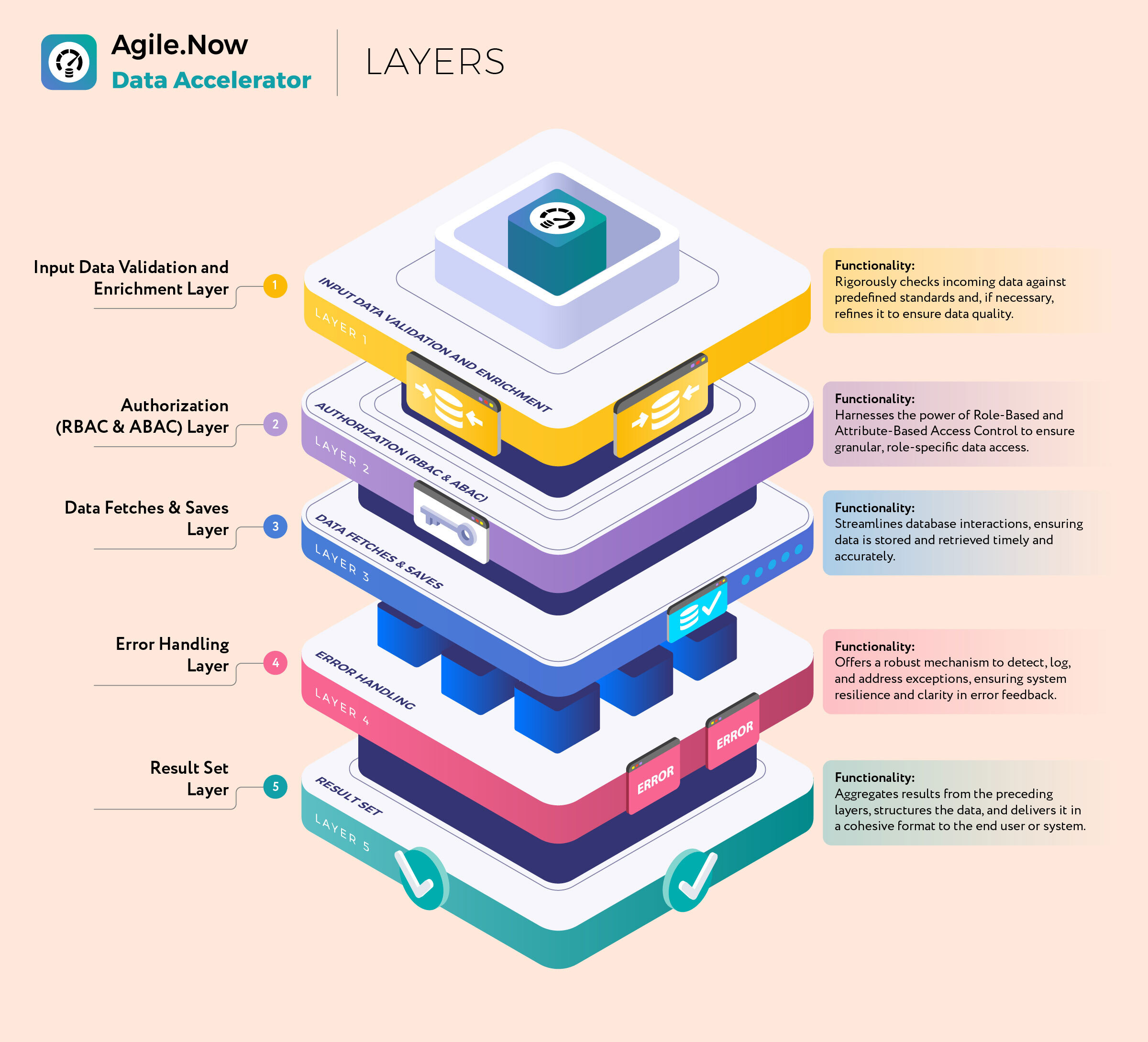- 28 Nov 2023
- 2 Minutes to read
- Print
- DarkLight
Layered Architecture of the Data Accelerator
- Updated on 28 Nov 2023
- 2 Minutes to read
- Print
- DarkLight
In the current digital transformation era, data plays an intrinsic role in shaping business decisions, user experiences, and operational efficiencies. However, managing this data, ensuring its integrity, and accessing it securely and efficiently presents inherent challenges. Enter the Agile.Now Data Accelerator, a specialized solution curated to streamline data operations within the OutSystems environment. This article aims to unfold the multi-layered architecture of the Agile.Now Data Accelerator, spotlighting its significance, functionalities, and the manifold advantages it brings to the table.
The Agile.Now Data Accelerator presents a structured paradigm for data management in OutSystems. By encapsulating functionalities within distinct layers, it ensures that every data operation, from validation to retrieval, is handled with precision, consistency, and security. Let's unravel the intricacies of this architecture, emphasizing the purpose and functionalities of each layer.
The Layers of the Agile.Now Data Accelerator
The Agile.Now Data Accelerator is renowned for its meticulously structured layered architecture. This design ensures that every facet of data management is handled independently yet harmoniously.

Input Data Validation and Enrichment Layer
- Purpose: The frontline of data operations, ensuring the validity and richness of incoming data.
- Functionality: Rigorously checks incoming data against predefined standards and, if necessary, refines it to ensure data quality.
Authorization (RBAC & ABAC) Layer
- Purpose: Guarantees that data is accessed securely and only by entitled entities.
- Functionality: Harnesses the power of Role-Based and Attribute-Based Access Control to ensure granular, role-specific data access.
Data Fetches & Saves Layer
- Purpose: The heart of the accelerator, ensuring efficient data storage and retrieval.
- Functionality: Streamlines database interactions, ensuring data is stored and retrieved timely and accurately.
Error Handling Layer
- Purpose: Every system can encounter hiccups, but how they're managed can make all the difference.
- Functionality: Offers a robust mechanism to detect, log, and address exceptions, ensuring system resilience and clarity in error feedback.
Result Set Layer
- Purpose: The culmination of all prior processes, this layer ensures data results are consolidated and dispatched efficiently.
- Functionality: Aggregates results from the preceding layers, structures the data, and delivers it in a cohesive format to the end user or system.
Salient Benefits of Agile.Now Data Accelerator's Architecture
- Uniformity: Every data operation within the Agile.Now Data Accelerator adheres to a consistent design and best practices.
- Comprehensive Error Management: A unified approach to error detection and management ensures clarity and consistency in error feedback.
- Optimization: The design ensures reduced redundancy and enhanced speed in data operations.
- Future-proof: Designed with adaptability in mind, ensuring it can accommodate evolving data complexities.
- Fortified Security: Multiple layers of security checks guarantee data integrity and protection against potential breaches.
Architectural Best Practices
The strength of the Data Accelerator's architecture lies in its foundational design principles:
- Decoupled Design: Segregates logic and in-memory data, fostering clarity and manageability.
- Repository Design Pattern: Provides an encapsulated mechanism for CRUD operations, ensuring data access uniformity.
- Holistic Error Handling: Ensures a consistent error feedback mechanism throughout the accelerator.
- Entity Validation at Construction: Guarantees that only valid data entities are created, ensuring data integrity.
Conclusion
The Agile.Now Data Accelerator's layered architecture represents a paradigm shift in how data operations are managed within OutSystems. By offering a unified, secure, and efficient approach, it redefines the benchmarks for data management. Adopting such a comprehensive architecture provides invaluable insights into contemporary, efficient, and consistent data management practices, making it an indispensable tool for any OutSystems developer.


